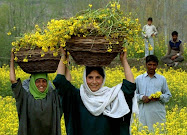The modern times witnessed the total face of Kashmir changed from chaste Hindu cult to the fundamentalist Muslim way of life. Down to the period of Budshah (Sultan Zain-Ul-Abidin) son of Sultan Sikandar (the iconoclast) at whose hands the worst happened in this calm happy abode of the gods, the conditions remained unchanged. However, in the reign of Budshah, the Hindus began showing their presence in very small numbers as the king was lenient towards them and allowed them to settle of their own. This change of heart was actually the result of a serious illness of the King Budshah and the miraculous treatment and cure by one noted KP physician, Shree Bhat by name. It’s said on his recovery Shree Bhat was asked to name a reward for the miraculous treatment of the King and strangely he didn’t ask anything for himself but urged the king to be patient towards his KP brethren by allowing them to live comfortably at their places and take steps to call back all those who had fled for their lives outside or were hiding at unknown places. The King responded immediately and thus began an era of consolidation for the left over Pandits of Kashmir in the valley. So by their capacity to accommodate in the new environment the KPs started living with their Muslim neighbours very humbly. They continued their religious pursuits and learning and tried to maintain their distinct cultural identity. The left-over places of worship were maintained and looked after but they had to accept the supremacy of their Muslim lords and thus adapted themselves according to the new environment. But unfortunately their woes had not entirely come to an end. There was much more suffering in their lot. In AD 1586 Kashmir was captured by the Mughal Kings and became part of the vast empire of Mughals. The reign of Akbar , Jahangir and Shahjahan was an era of consolidation and peace but Aurangzeb, son of Shahjahan resumed the reign of terror for Hindus and it was again the worst period for Kashmir Pandits as the king wanted all of them either converted or put to sword. Sher Afghan who was appointed the Governor of Kashmir had ordered all the left over temples of Kashmir converted into mosques and wholesale conversion of all Hindus. After the death of Aurangzeb in 1753 Kashmir came under the rule of Afghans and the atrocities on KPs continued unabated. They crossed all limits of cruelty in converting the left over Pandits who were practically hiding in forest areas and other unknown places. Rewards were given to people for killing Pandits wherever found and they were hounded as the animals of prey. Kashmir had no longer remained a Hindu Kashmir as the new lords tried to change her wholly by building powerful installations of Muslim culture and religion in place of old intricate Hindu fabric.
Surprisingly everything seemed to have changed on the face of it but strangely the basic elements remained unchanged in the valley. The traces remained there and showed their influence on everything. The solid deep roots of Hindu culture remained embedded under the soil of the changed environment and the change at times seemed superficial. Every new structure had its original roots alive sprouting their influence every now and then although the forces tried to cut them as deep as possible. As such Kashmir culture gave rise to a synthesis of the old order and the new change. Various indications in the form of a mixed culture were seen here and there. Some time a Muslim poet sang the glories of Hindu mythology or a saint became an adorer of Hindu gods and traditions, quite contrary to the beliefs of Muslim extremist attitude of religion. This attitude usually angered the religious bigots of the time but strangely enough the public at large didn’t raise objections to it but rather cherished such orations.----- (to be continued)
Subscribe to:
Post Comments (Atom)
.jpg)




No comments:
Post a Comment